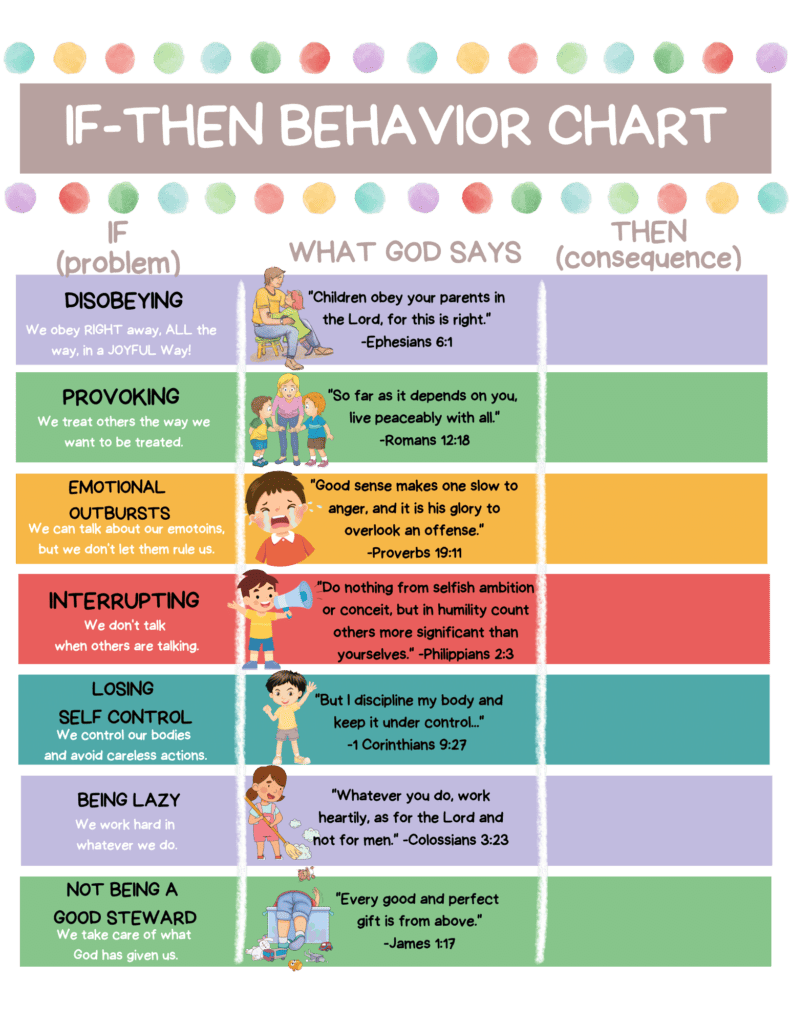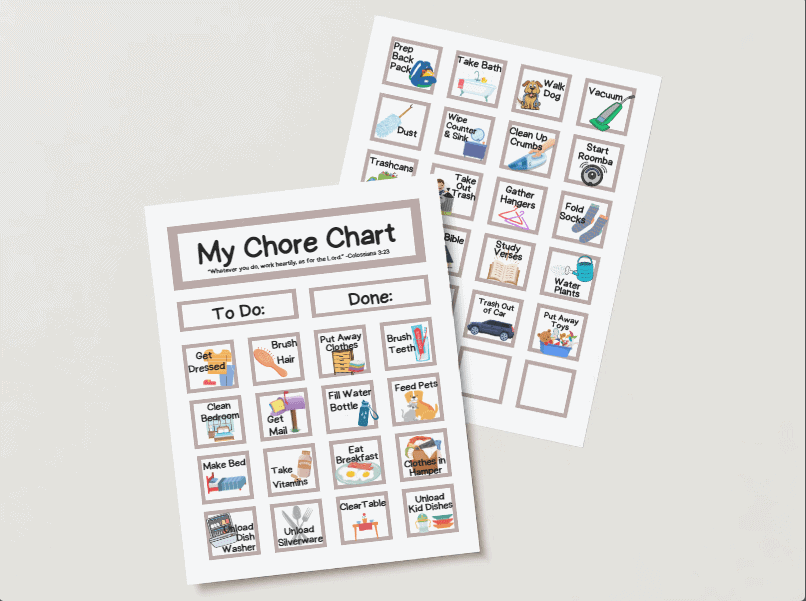Trouble with your child’s behavior and discipline? An If-Then Behavior Chart can help reform your approach OVERNIGHT, and it can help Mom and Dad stay on the same page day in and day out!
Imagine this…What if your entire family had just 7-8 expectations, clearly outlined them, and reviewed them often? And what if each time there was a misbehavior, it was promptly, calmly, and fairly addressed, all while pointing your kids’ back to God’s Word? Sound too good to be true? Just keeping reading…
Click HERE to get your copy of this If/ Then Chart
The Discipline Struggle
When my oldest child was 3, my husband and I were REALLY struggling with discipline. As Christian parents, we wanted to raise him up in the nurture and admonition of the Lord, but we had no clue how to get our rebellious, strong-willed son on track.
In truth, we never really sat down and discussed our parenting strategies or form of discipline. Instead, we were mostly relying on what we’d experienced with our own parents or different ways we saw friends handling negative behavior with their kids. Actually, we were flying by the seat of our pants with no plan. Just getting through each situation however we could.
One day, I was dealing with more of our son’s behavior problems at a church meeting. It was bad. I was negotiating with my son, counting to 3, making threats…everything I could think of to get him to obey. And none of it was working. My 3 year olds stubbornness was on display for all to see, and I was completely helpless to address it.

A sweet, wise, mentor-mom noticed the situation and stepped in. She asked me if I’d ever considered the importance of discipline in the Christian home. She also asked if I’d be open to a Biblical parenting course she and her husband were teaching. Before she finished her question, I was shouting, “YES!!!”
My husband was on board with taking the course, and it began just a few weeks later. That time spent looking at God’s word and what it has to say about our children’s behavior was transformational. It changed my own life as a mom, but more than that, it completely transformed the tone of our home.
And I say this with humility…as an encouragement to any Mama who may think the behavior is too far gone to be redeemed…we now get compliments all of the time on our 4 children’s behavior. Just yesterday our babysitter was telling me how we were her favorite family to work for because our children are so well-behaved. Oh, if she could have only seen us 10 years ago when we were in the midst of the struggle! She would have run away, never to return! Yes…it was that bad! Simply awful.
But praise God for that sweet, bold mom who approached me. Praise God for that parenting course that put us on a different path. Praise God for His word and direction for parents. And I’m pretty thankful for discovering the If/Then Behavior Chart too!
Why Secular Methods of Discipline Fall Short
All good parents want their children to display good behavior. But a Christian parent is working on much more than teaching our kids to do the right thing. We are trying to get at the heart of a child.
We want to point them to Jesus Christ and encourage them down the right path. We seek for their lives to display the Fruit of the Spirit (love, joy, peace, patient, kindness, goodness, faithfulness, gentleness, self control). We are raising them up in the instruction of the Lord, and praying for the Holy Spirit to change our child’s heart, not just our child’s behavior.
So, while the secular goal is nice kids who get along well with others, we are looking to God’s wisdom when it comes to our kids’ behavior. We want our kids to obey authority- first their parents’ authority and soon God’s authority (Ephesians 6:1- “Children, obey your parents in the Lord, for this is right,”).
We want our kids to love the Lord and love others well (Mark 12:30-31- “And you shall love the Lord your God with all your heart and with all your soul and with all your mind and with all your strength.’ The second is this: ‘You shall love your neighbor as yourself.’ There is no other commandment greater than these.”).
Christian parents are always seeking to give our kids the truth of the Biblical worldview, even when it comes to behavior and discipline. We realize that Biblical discipline is one more seed we plant that will hopefully grow into a heart change that causes our children to believe the good news of the Gospel. So, in short, we want everything we do to point back to God’s word and God’s love.
But how do we execute discipline based on Biblical principles consistently and fairly day in and day out? Well, that’s where the If/Then Chart has become one of the most wonderful tools in our parenting toolbox!
Benefits of the If/Then Method
Life is busy, and behavior issues often arise at the most hectic times. But part of our job as parents is to address those issues, no matter what else is going on. But how?? Boots on the ground, what does it look like?
First, let’s talk about the steps for implementing your chart.
- Get a Chart– It doesn’t have to be fancy. You can write out a chart on notebook paper. Or you may choose to make one on the computer to incorporate illustrations that help young children “read” the chart. You may also choose to grab my chart here. Decide on 5-10 expectations for your home. Use scripture to help you outline the Lord’s commands.
- Mom and Dad Fill Out Chart Together– Mom and Dad find a quiet time, maybe after the kids are in bed, to brainstorm. They consider the common misbehavior problems and decide on appropriate consequences that can truly help to correct them. Then they record them on the chart. These consequences can range from natural consequences, to time-out, to loss of privileges, to issuing apologies, and even spankings. But regardless of which consequence you deem appropriate, you can avoid punishing your children out of anger simply because you’ve thought through the issue BEFORE the trouble arose.
- Post the Chart- Post the chart in a central location in the home. You’ll be visiting it often!
- Explain the Chart- Find a time when Mom and Dad can introduce the chart to the kids together. Explain the expectations, give examples and scenarios, and answer any questions.
- Implement the Chart- When discipline issues arise, calmly and promptly, take the child to the If/Then Chart. Point to the corresponding expectation. Read it aloud and review what God says about that behavior. Point out the pre-determined consequences of their actions. Calmly and lovingly, follow through with those consequences.
- Follow Up- Follow up with further conversation about the behavior as needed.
Let’s also review the benefits of this method.
- No Thinking On-the-Spot Required– Because the chart is prepared in advance, there is no thinking required in the heat of the moment when discipline is needed.
- Remembering What You Said Before is Not Required– You’ve recorded the misbehavior problem and its consequence clearly on the chart and posted the chart in a central location for the whole family to see. So, no surprises for the kids, and no remembering for the parents.
- Communicating about Behavior is Thorough– As mentioned before, Mom and Dad have already clearly communicated about the If-Then Behavior Chart and recorded their agreed-upon plans. It doesn’t matter which parent takes the child to the chart to address the current behavior, both parents are on the same page. Being on the same page is good for the marriage and it’s healthy for the children to see. No “good cop, bad cop” parenting here. Mom and Dad become a unified team that are working to help their children overcome misbehaviors and conduct themselves in a way that’s pleasing to the Lord. What a blessing for all!
- Expectations are Clear– Sometimes we can ask too much of our children. We can have 1,000 little rules that we expect them to remember and follow. But with an If-Then Behavior Chart, we consistently point them back to the same handful of expectations. The expectations are the same for all of the children (perhaps in slightly different applications depending on the child’s development and needs). Ambiguity and favoritism are removed from the equation, and it becomes much more do-able for children to rise up to the outlined expectations.
- God is Glorified– The chart helps the kids understand that we aren’t dictators enforcing random rules that we thought up on the fly. We are a family grounded in God’s word. We seek to obey Him and glorify Him. And the chart is a tool that helps us stay on course towards that goal.
Final Thoughts on the If/ Then Behavior Chart
If you’re like me, as soon as I heard of this method, I KNEW it was what we needed. I knew it was the best way to address wrong behavior while also promoting right behavior. And I loved that it was one more way that we could “teach them diligently to your children” as we pointed them to God’s word over and over again.
If you’re struggling with behavior, let me offer a final encouragement. When executed consistently, the If-Then Behavior approach provides a calm, loving, predictable pattern that REALLY can transform discipline in your Christian home. I promise! Stay the course, parents, stay the course.
Want a printable copy of my If-Then Behavior Chart? You can jump straight to the chart here.
Or visit my Printables Store for all of my parenting printables and more!
For more Christian parenting ideas, please visit my Raise Them with Diligence page.




